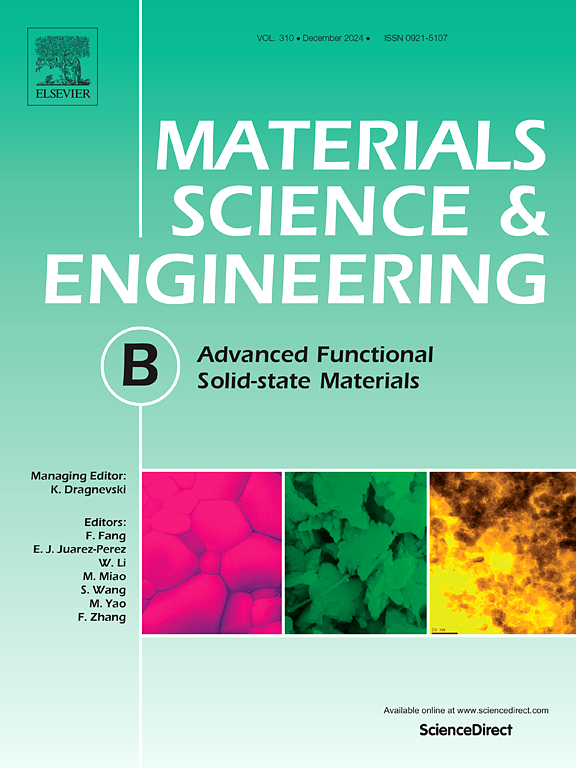Advancing in Situ synthesis of Zn3(OH)2V2O7·2H2O/Betalains nanocomposite for simultaneous enhancement of electrochemical performance and green energy storage in high-performance Li-Ion batteries and supercapacitors
IF 3.9
3区 材料科学
Q2 MATERIALS SCIENCE, MULTIDISCIPLINARY
引用次数: 0
Abstract
Metal vanadates are exceptional for electrochemical energy storage, and their nanocomposites outperform traditional metal oxides. Incorporating bio-inspired components with advanced designs improves performance, benefiting Li-ion batteries (LIBs) and supercapacitors for sustainable energy storage solutions (ESS). Hydrated metal vanadates are promising for the ESS owing to their large capacity, structure, low cost, and abundant resources. We present a new Zn3(OH)2V2O7·2H2O/Betalains nanocomposites (ZVH@Bn NCs) utilizing natural betalain pigment for green energy devices such as LIBs and supercapacitors for the first time. This is achieved through one-step synthesis through a water-soluble betalain extract-assisted low-temperature hydrothermal method. The study details the enhanced features of the composite, including improvements in morphology, electrical, optical, and electrochemical properties, which enhance Li+ storage processes. Betalains, acting as a stabilizing and capping agent, enhance the charge storage mechanism by preventing surface oxidation. They improve electrical conductivity by facilitating faster charge transfer and lowering the band gap of the NCs. With a high potential window of 2.4 V, ZVH@Bn as a supercapacitor exhibited stable cyclic voltammograms even at high scan rates (10,000 mV/s). The highest energy density and power density were obtained to be 13.53 Wh/kg and 1114.9 W/kg, respectively. ZVH@Bn NCs serve as an anode material for energy storage in the form of LIBs, with an initial discharge capacity of 1200 mAh/g. The specific capacity was found to be 742 mAh/g, even after 100 cycles at a 0.1C rate. Their stability, eco-friendliness, and efficiency suggest suitability for reliable, sustainable energy storage applications.

金属钒酸盐在电化学储能方面非常出色,其纳米复合材料的性能优于传统的金属氧化物。将生物启发成分与先进的设计相结合可提高性能,有利于可持续储能解决方案(ESS)中的锂离子电池(LIB)和超级电容器。水合金属钒酸盐具有容量大、结构好、成本低和资源丰富等优点,因此在可持续储能解决方案(ESS)中大有可为。我们首次提出了一种新型 Zn3(OH)2V2O7-2H2O/Betalains 纳米复合材料(ZVH@Bn NCs),该材料利用天然甜菜色素,可用于 LIB 和超级电容器等绿色能源设备。这是通过水溶性甜菜碱提取物辅助低温水热法一步合成实现的。该研究详细介绍了该复合材料的增强特性,包括形态、电学、光学和电化学性能的改善,从而增强了 Li+ 的存储过程。白桦脂作为一种稳定剂和封盖剂,通过防止表面氧化增强了电荷存储机制。它们能加快电荷转移并降低 NC 的带隙,从而提高导电性。作为超级电容器的 ZVH@Bn 具有 2.4 V 的高电位窗口,即使在高扫描速率(10,000 mV/s)下也能显示稳定的循环伏安图。最高能量密度和功率密度分别为 13.53 Wh/kg 和 1114.9 W/kg。ZVH@Bn NCs 可作为锂电池储能的阳极材料,其初始放电容量为 1200 mAh/g。即使以 0.1C 的速率循环 100 次,比容量也达到了 742 mAh/g。这种材料的稳定性、生态友好性和效率表明,它适用于可靠、可持续的能源储存应用。
本文章由计算机程序翻译,如有差异,请以英文原文为准。
求助全文
约1分钟内获得全文
求助全文
来源期刊

Materials Science and Engineering: B
工程技术-材料科学:综合
CiteScore
5.60
自引率
2.80%
发文量
481
审稿时长
3.5 months
期刊介绍:
The journal provides an international medium for the publication of theoretical and experimental studies and reviews related to the electronic, electrochemical, ionic, magnetic, optical, and biosensing properties of solid state materials in bulk, thin film and particulate forms. Papers dealing with synthesis, processing, characterization, structure, physical properties and computational aspects of nano-crystalline, crystalline, amorphous and glassy forms of ceramics, semiconductors, layered insertion compounds, low-dimensional compounds and systems, fast-ion conductors, polymers and dielectrics are viewed as suitable for publication. Articles focused on nano-structured aspects of these advanced solid-state materials will also be considered suitable.
 求助内容:
求助内容: 应助结果提醒方式:
应助结果提醒方式:


